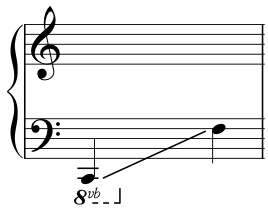Major-third harmonics
Fifth partial harmonics are usually called third harmonics or major-third harmonics among harpists. The name refers to the resulting sound of two octaves and a major third above the fundamental.
Production
The string is stopped with the knuckle or the side of the hand at a point that is exactly 4/5 of the string's total length away from the soundboard. The thumb or the second finger plays the upper 1/5 of the string. As the finger plays the string, the knuckle or the base of the hand leaves the string, letting it resonate.
Sound
Major-third harmonics sound quite soft and are not as clear as other harmonics. The sound is a little distorted. The pitch follows the natural overtone series and is therefore 13.7 cents lower than the same note in equal temperament.
Notation
Major-third harmonics are notated with a little diamond placed a third above the played string. The note sounds two octaves and a major-third higher. To avoid confusion it is helpful to write the sounding pitch in parentheses above the note the first time such a harmonic occurs.

Major-third harmonic.
Range
Only the lower (longer) strings can be used to produce major-third harmonics:

Range for major-third harmonics.
N.B. Harmonics in the lowest octave of the harp sound soft and rather undefined.